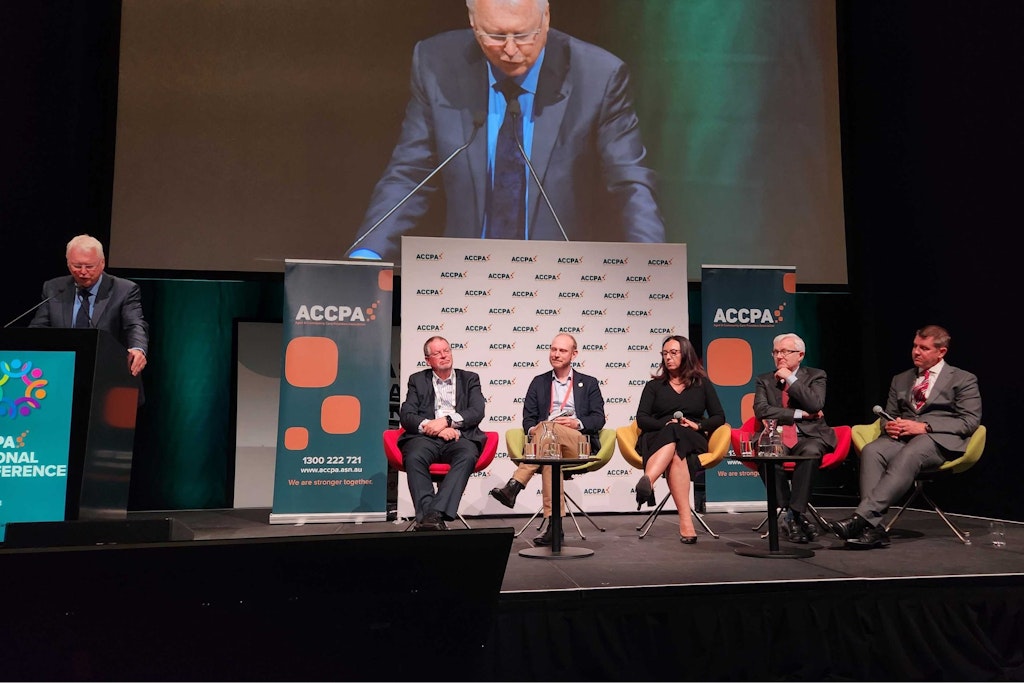Taskforce touches on sustainability and the future of reforms
Published on 30 October 2023 (Last updated on 7 November 2023)

Last week, aged care leaders gathered for the industry’s peak event, the Aged & Community Care Providers Association (ACCPA) National Conference, in Adelaide. Among the highlights was a conversation early Wednesday morning, where members of the Aged Care Taskforce gathered to share insights ahead of their interim report.
That report will be released in December, providing the sector with a clearer picture of what the future holds for it regarding funding arrangements, system sustainability, innovation and more.
However, the Taskforce confirmed there will be no explicit recommendations handed down. Tom Symondson, ACCPA CEO, told the crowd this is because there is a significant gap between where the sector is now and where it needs to be for financial sustainability and more time is needed to flesh out the right solutions.
“The reality is the size of the gap is so significant that one approach, one flick of the switch, won’t fix it. So what Government is going to end up with [is] a whole heap of decisions they have to make,” Mr Symondson said.
“There will be a range of things I’ll put to Government to solve the problem. I think one of the problems for the Royal Commission into Aged Care Quality and Safety was there was a little bit of a ‘do this and it will fix it’. We look at that and go ‘not on its own, not designed that way’.”
“It has to be multifaceted. Just the scale of the money we need to get into our sector to make it what we all want it to be is so eye-wateringly enormous there is no single solution.”
Grant Corderoy, Senior Partner StewartBrown, expanded on where the Taskforce’s frame of mind currently stands. He said there is a unanimous recognition that the sector needs more funding, providers need to be more financially sustainable to innovate and invest in new models of care, and that aged care in ten years will look completely different.
“What we have to do now as a taskforce is to maintain clarity. We need actionable recommendations and a clear agenda that is equitable, has to support a safety net and has to be transparent,” Mr Corderoy said.
“This is a generational opportunity and I’m confident the Taskforce has the clarity and the understanding of the challenge to say that if we can put in a framework that’s not fixing aged care next year… it’s putting in the framework that we can now move to the next generation of aged care in a sustainable manner.”
Are no recommendations equal to no consensus?
With no specific recommendations set to land, does that mean the Taskforce has failed to reach a consensus on what the sector needs to achieve sustainability? Probably not. A 16-person strong Taskforce means there are differing opinions but Mary Patetsos AM, ACH Group Chair, said there’s a benefit in not providing a consensus in the interim report if some members have been forced to agree to ideas they do not believe in.
Instead, it may offer a range of solutions at times, representing the breadth and diversity of the group. When asked whether there was division within the Taskforce about the proposed models for funding aged care, Ms Patetsos adamantly rebuffed the idea.
“There is very little division. What there is is a full appreciation of all the facts, the different perspectives and the need to move forward perhaps in a way we’ve never moved forward before,” she said.
“It’s about an open conversation that is considered and knowledgeable and goes to experts external to the group. What we don’t want is somehow what’s happened in the sector where we reform and bolt on. We have a system where we think ‘It’s not working, we just put this on top of it as well’ and then it’s a bit clunky.”
Open conversations have seen various funding models explored, including a levy that would see taxes raised and an altered co-contribution model where wealthier people would pay more for their care. This in itself could influence change on lifetime means tests and is seemingly the preferred model if provider reactions are anything to go by.
Mike Baird, HammondCare CEO, also spoke of the need to bring new capital and new investors into aged care. He acknowledged banks as one source of increased investment. The potential for portions of superannuation to be directly funded into aged care may also feature in the interim report, although that was not a popular idea when mentioned earlier in the year.
Reform layering has to end
While discussing the potential for a new system of co-payments, Mr Symondson pointed out that there are aged care consumers already contributing to their care in the form of co-contributions. However, he said that with any future regulation changes impacting consumer payments – or in fact, any reform changes – there must be a ‘one in, one out’ approach.
“Every piece of regulation that gets added should erase something else. If you’re going to add a burden… you have to access the quantifiable impact of that burden and remove something else,” Mr Symondson said.
He added that this will require additional trust from the Government as they need to view the aged care sector as something that can do the right thing and put in place rules for those who do not. If the words of the Taskforce are anything to go by now, that trust is increasing. Hopefully, it will be even stronger once the interim report is released in December and a clear path towards sustainability is within sight.